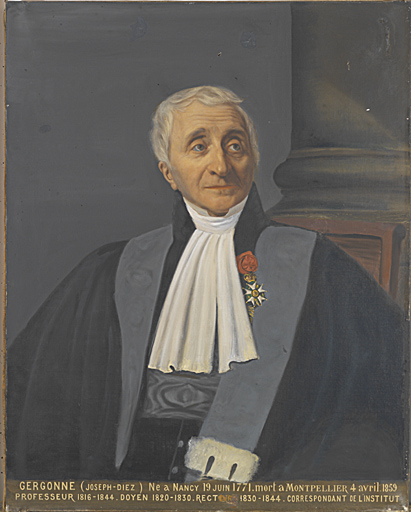<Back to Index>
- Mathematician Joseph Diaz Gergonne, 1771
- Sculptor John Gibson, 1790
- King of Scots and King of England and Ireland James VI and I, 1566
PAGE SPONSOR

Joseph Diaz Gergonne (19 June 1771 Nancy, France — 4 May 1859 Montpellier, France) was a French mathematician and logician.
In 1791, Gergonne enlisted in the French army as a captain. That army was undergoing rapid expansion because the French government feared a foreign invasion intended to undo the French Revolution and restore Louis XVI to full power. He saw action in the major battle of Valmy on 20 September 1792. He then returned to civilian life but soon was called up again and took part in the 1794 French invasion of Spain. In 1795, Gergonne and his regiment were sent to Nîmes. At this point, he made a definitive transition to civilian life by taking up the chair of "transcendental mathematics" at the new École Centrale. He came under the influence of Gaspard Monge, the Director of the new École Polytechnique in Paris.
In 1810, in response to difficulties he encountered in trying to publish his work, Gergonne founded his own mathematics journal, officially named the Annales de mathématiques pures et appliquées but generally referred to as the Annales de Gergonne. The most common subject of articles in his journal was geometry, Gergonne's specialty. Over a period of 22 years, the Annales de Gergonne published about 200 articles by Gergonne himself, and other articles by many distinguished mathematicians, including Poncelet, Servois, Bobillier, Steiner, Plücker, Chasles, Brianchon, Dupin, Lamé, even Galois.
Gergonne
was appointed to the chair of astronomy at the University of
Montpellier in 1816. In 1830, he was appointed Rector of the University
of Montpellier, at which time he ceased publishing his journal. He
retired in 1844. Gergonne was the first mathematician to employ the word polar. In a series of papers beginning in 1810, he discovered the principle of duality in projective geometry,
by noticing that every theorem in the plane connecting points and lines
corresponds to another theorem in which points and lines are
interchanged, provided that the theorem embodied no metrical notions.
In 1816, he devised an elegant solution to the problem of Apollonius: find a circle which touches three given circles. In 1813, Gergonne wrote the prize-winning essay for the Bordeaux Academy, Methods of synthesis and analysis in mathematics, unpublished to this day and known only via a summary. The essay is very
revealing of Gergonne's philosophical ideas. He called for the
abandonment of the words analysis and synthesis,
claiming they lacked clear meanings. Surprisingly for a geometer, he
suggested that algebra is more important than geometry, at a time when algebra consisted almost entirely of the elementary algebra of the real field. He predicted that one day quasi-mechanical methods would be used to discover new results. In 1815, Gergonne wrote the first paper on the optimal design of experiments for polynomial regression. According to S.M. Stigler, Gergonne is the pioneer of optimal design as well as response surface methodology.